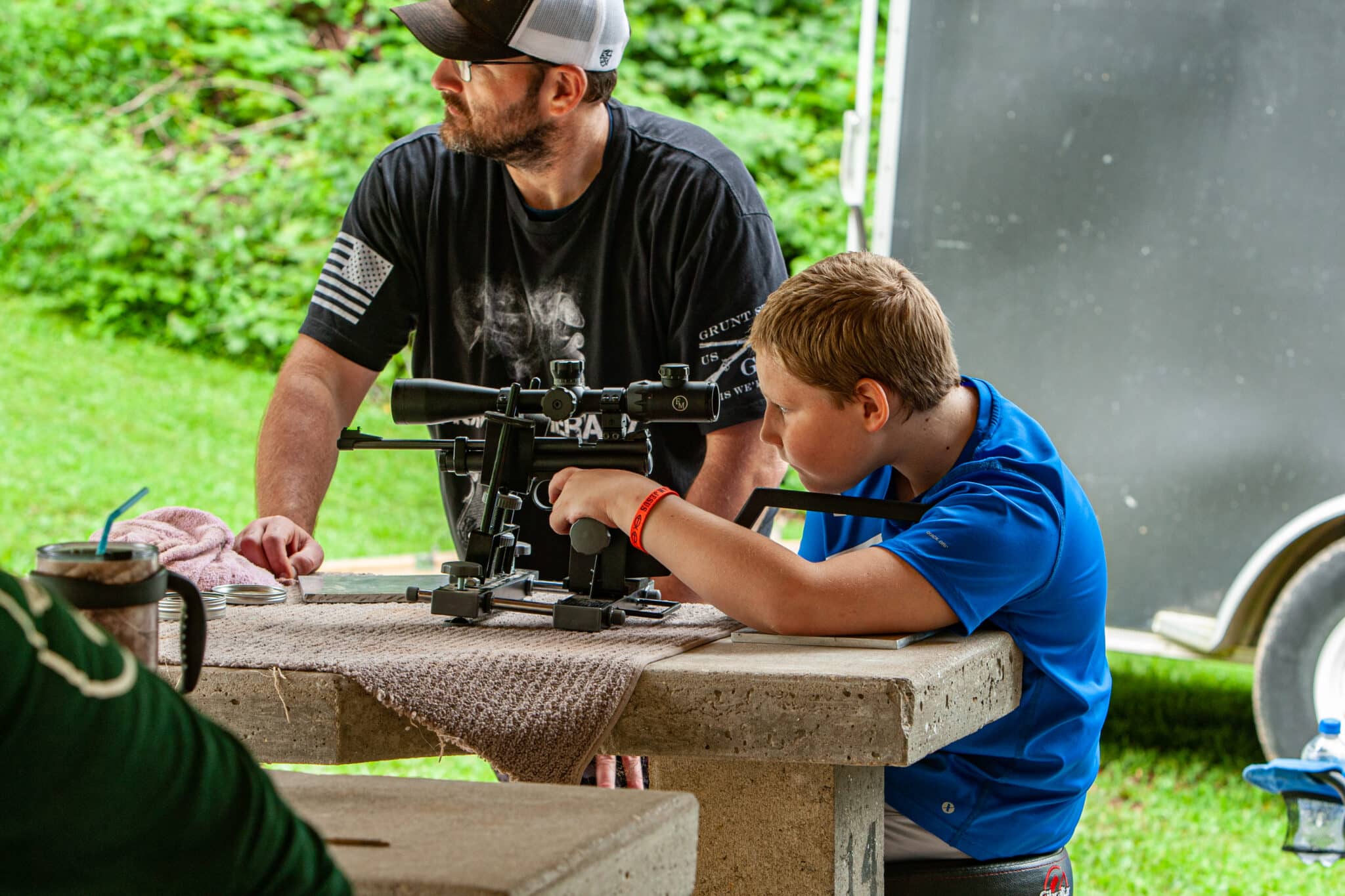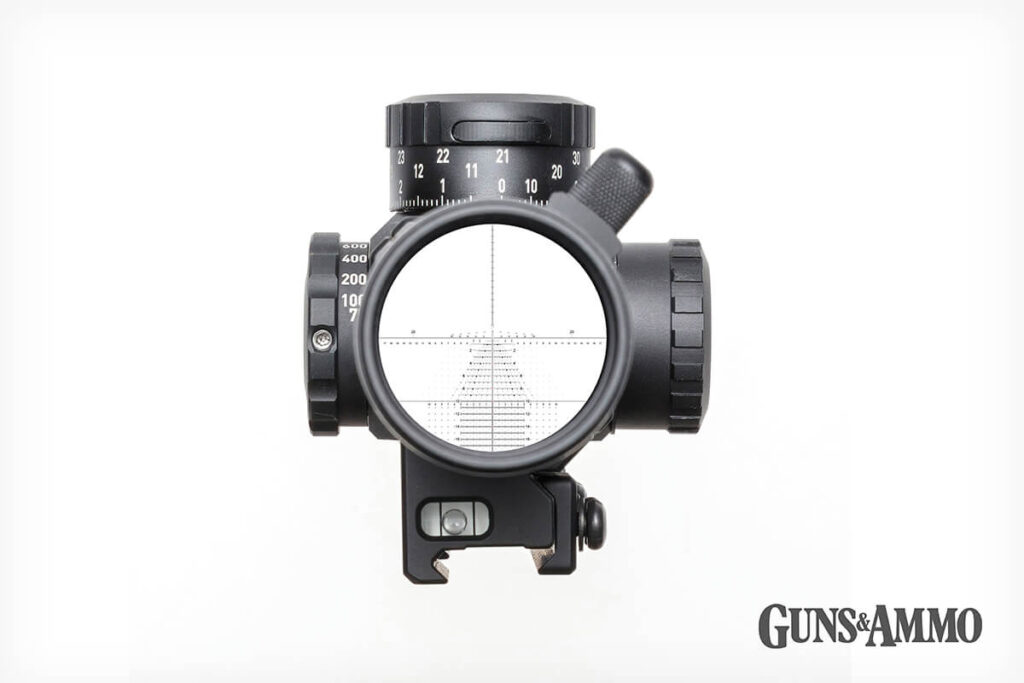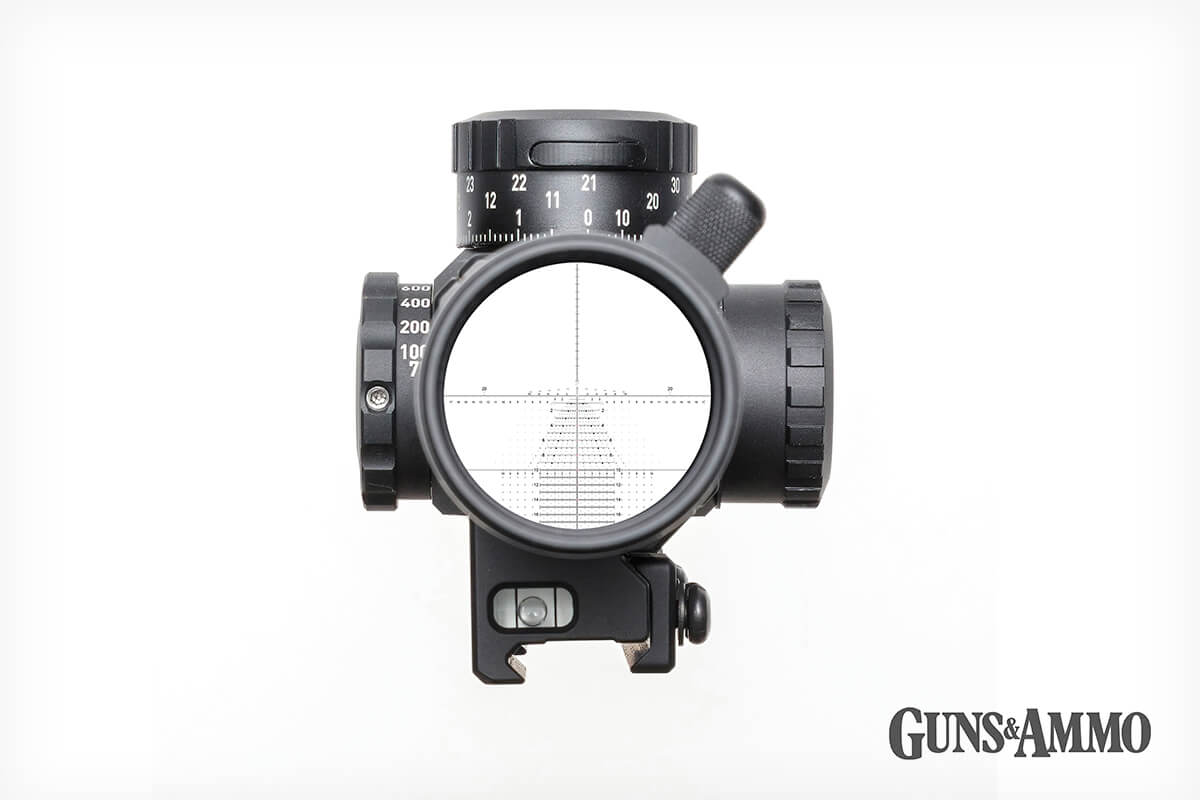Gone are the days of the simple duplex. Now, other options, such as First-Focal-Plane (FFP), Second Focal Plane (SFP), Ballistic Drop Compensating (BDC), Crosshair with .2-Mil or 1-MOA, and “Christmas Tree” are available. Know which one to choose by looking at these principles of reticles selection.
With the ever-increasing supply of rifles and scopes has come a seemingly endless number of reticles. In place of the duplex reticle are both better and worse options. Let’s take a look at the principles of reticle selection without nerding out too hard on the subject.
First or Second Focal Plane?
First-focal-plane (FFP) reticles get bigger or smaller as magnification changes because the reticle is always the same size relative to the target. This allows FFP reticles to show accurate subtension, i.e., the reticle measurement of objects in the field of view using milradian (mils) or minute-of-angle (MOA) marks on the reticle at all magnification levels. FFP reticles are enjoying peak popularity today, but many shooters are ill-served by them.
The trick to knowing when to select FFP or Second Focal Plane (SFP) is to assess where in the magnification range the scope will spend its time. If the scope will be used almost exclusively in the top half of its magnification range, FFP would be my first choice. Shooters that spend most of their time in this magnification range are military snipers, competitive shooters and some recreational target shooters. The reason FFP reticles are a poor choice for scopes frequently used in the lower half of the magnification range is because the reticle becomes so small that it is hard to see and use accurately.
Second-focal-plane reticles are the best choice if the scope will see a third or more use in the lower half of the magnification range. SFP reticles stay the same size regardless of magnification level, so they are always easy to see. This is one of the key features that makes it so attractive and useful. Shooters best served by SFP reticles include law enforcement snipers, hunters and anyone with seasoned eyesight. A SFP reticle doesn’t get enough attention these days because it has been around for a while, but it is far more useful than many believe. The biggest complaint about an SFP reticle is that it only subtends accurately at one magnification, usually the scope’s maximum magnification. However, a simple rule to remember for SFP reticles is, “Cut the magnification in half, cut the hold in half.” This means a shooter using a 4-mil hold at maximum magnification on a 4-16X scope could use a 2-mil hold at 8X and get the same result. Those unafraid of fractions can apply this rule to any magnification level, but the fast, simple, and memorable rule of halves has many applications and obviates the old argument that SFP reticles have limited use.
Ballistic Drop Compensating (BDC)
These reticles sound good and brief well, but are usually a let-down. BDC reticles are designed to zero at 100 yards and then have hold-over points on the reticle for 200-, 300- and 400-yards (or something similar). The problem is BDC reticles only really work for the military because they intimately know their rifle, optic mount and ammunition used with their optic. There is no way to tell where a BDC reticle will actually match up with an individual’s rifle and ammunition without knowing the bullet’s muzzle velocity, ballistic coefficient (BC), and the optic’s height above the bore. Good BDC reticles will state where the BDC marks subtend so the customer can check them against a ballistic calculator to get accurate distances. But there are easier and more elegant solutions, too.
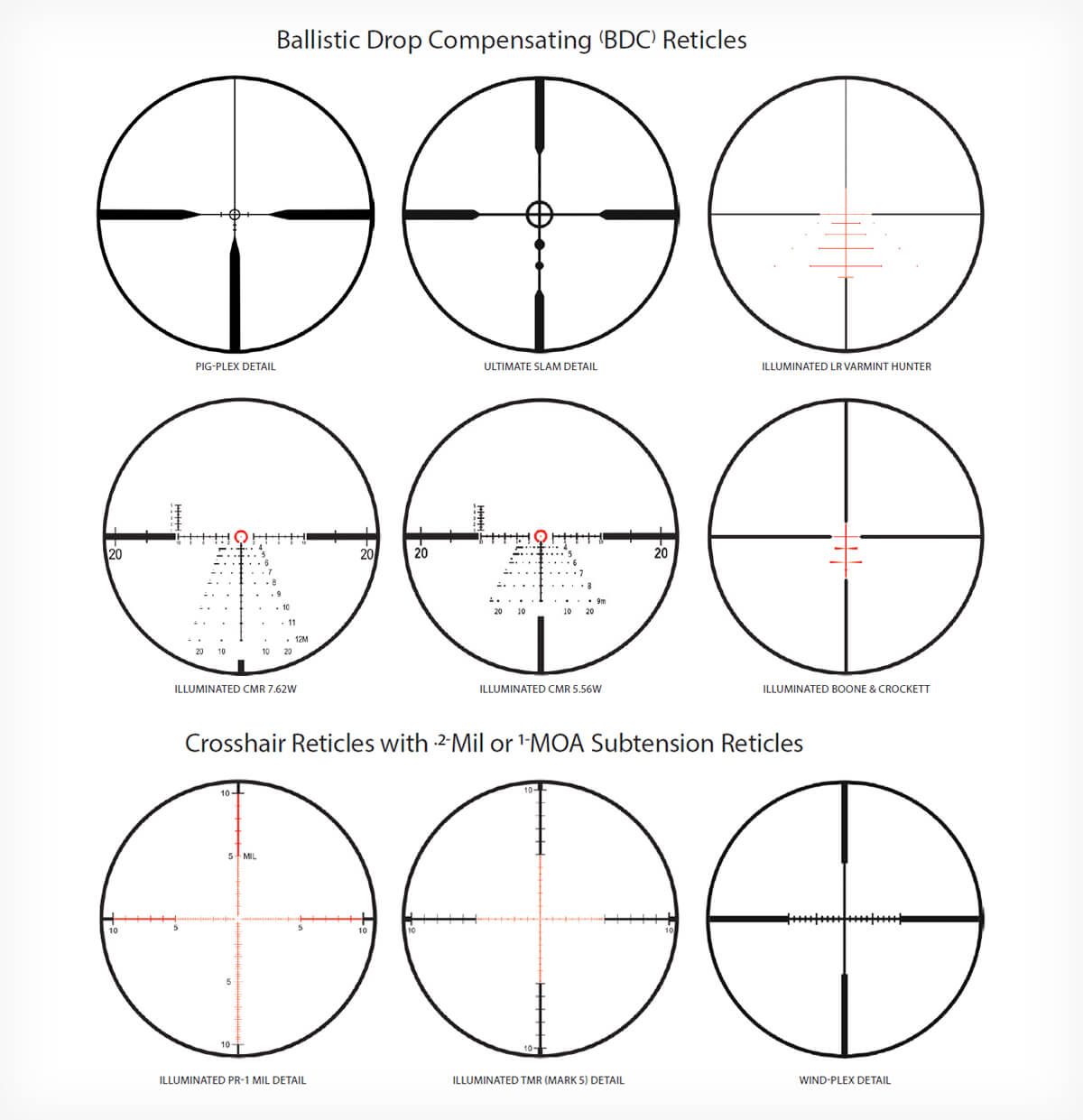
Crosshair Reticles with .2-Mil or 1-MOA
Of all the good and bad things to come from the reticle revolution, these reticles, combined with exposed elevation turrets designed for dialing elevation corrections are the most useful in both SFP and FFP scopes. For those not inclined to use anything but the center of the crosshair, these reticles work just as any duplex model. For those looking for accurate wind holds or elevation holdovers, these types of reticles work well for that. No other reticle type has a simpler appearance while still offering lots of flexibility for holdoffs and holdovers. If I were a die-hard duplex-reticle guy and wanted to branch out into reticles that presented more options to the shooter, this would be the first place I’d start. Some examples of these reticles are the PR-1 and TMR reticles from Leupold. The best choice for a transition scope to get a shooter to explore more sophisticated options than a simple duplex crosshair is Leupold’s VX-3HD 4.5-14x40mm with Wind-Plex reticle. With just a bit of research from home, a shooter could send their load data to Leupold and receive a custom elevation turret based on the distance to the target. Slap that turret on this scope and the shooter can range a target with a laser rangefinder, dial the elevation turret to the distance that the rangefinder indicates, and hit with confidence out to 600 or 700 yards. I used Leupold’s Custom Dial System (CDS) to take an Alaskan grizzly at 421 yards. The CDS works as advertised. When combined with the Wind-Plex reticle that shows wind holds in 1-MOA increments, the combination is effective in the toughest shooting conditions. It’s also a reasonably inexpensive option, selling in gunshops for about $600.
“Christmas Tree” Reticles
These are some of the most popular FFP reticles today, and there are a couple good reasons why. So-called “Christmas tree” reticles place the start of the tree at the center crosshair and then have various amounts of aiming points descending down and away from the center crosshair. Some tree reticles, such as the Tremor3, offer a lot of reference points and sophisticated features such as wind hold points established in miles per hour. The Tremor3 reticle has a lot going on in the field of view and, if it suits the shooter’s needs, it’s a fantastic reticle. The Tremor3 is issued by U.S. Special Operations Command (USSOCOM), and it’s just about perfect for military sniping because it works well with relatively large targets and multiple target engagements.
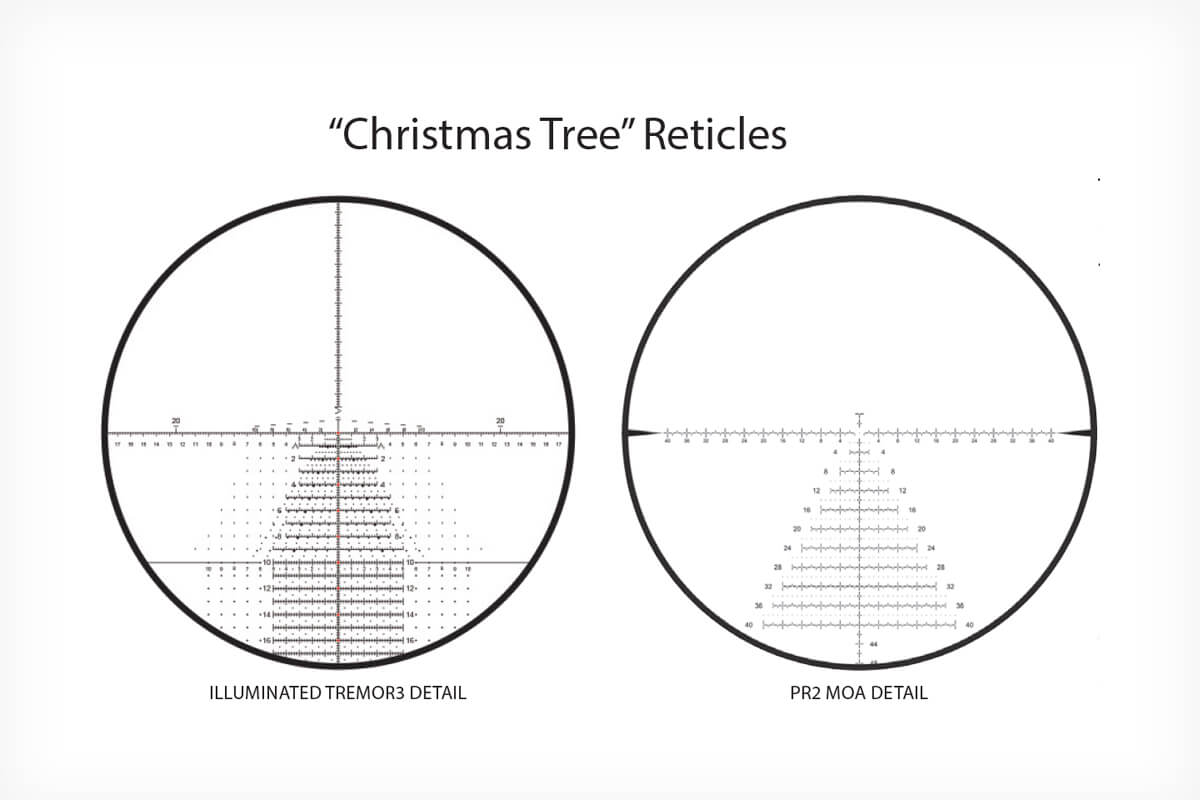
However, these reticles can cover up a lot of the field of view and make it hard to spot the impacts of rounds hitting near the target. This is the Tremor3’s biggest problem for the masses. A less cluttered reticle such as Leupold’s PR-2 is probably a better choice for all-around use.
A key aspect to keep in mind when debating between a traditional crosshair reticle and a tree-style reticle is that the tree is most useful when shooting at more than one target quickly. Crosshair reticles versus tree reticles is really a question of precision versus speed. Dialing each shot for elevation and holding off for wind is where the crosshair reticle shines. This is the most precise use of a riflescope available today. Tree reticles work well when, for example, I want to dial elevation for my first shot and then just hold over for the second target because I need to get hits as quickly as possible. Holding over for the second shot will be faster than dialing, although not quite as precise. Tree reticles are also advantageous when shooting past 1,000 yards because they allow for precise correction of both elevation and windage instead of just precise windage correction as with a crosshair-style reticle.
I’ll try to revisit this subject in the coming issues of Guns & Ammo to expand on some of the principles laid out in this column. If you want to try something more exciting than a Duplex reticle, get a SFP reticle that subtends to .2 mil or 1 MOA on the horizontal crosshair and put it in a scope with an exposed elevation turret meant for dialing. This is the first step to becoming proficient at hitting targets reliably and repeatably past 300 yards.


